-
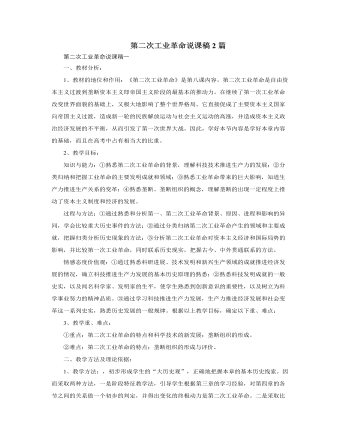
人教版高中历史必修2第二次工业革命说课稿2篇
②内燃机的发明推动了交通运输领域的革新。19世纪末,新型的交通工具——汽车出现了。1885年,德国人卡尔·本茨成功地制成了第一辆用汽油内燃机驱动的汽车。1896年,美国人亨利·福特制造出他的第一辆四轮汽车。与此同时,许多国家都开始建立汽车工业。随后,以内燃机为动力的内燃机车、远洋轮船、飞机等也不断涌现出来。1903年,美国人莱特兄弟制造的飞机试飞成功,实现了人类翱翔天空的梦想,预告了交通运输新纪元的到来。③内燃机的发明推动了石油开采业的发展和石油化学工业的产生。石油也像电力一样成为一种极为重要的新能源。1870年,全世界开采的石油只有80万吨,到1900年猛增至2 000万吨。(3)化学工业的发展:①无机化学工业:用化学反应的方式开始从煤焦油中提炼氨、笨、等,用化学合成的方式,美国人发明了塑料,法国人发明了纤维,瑞典人发明了炸药等。
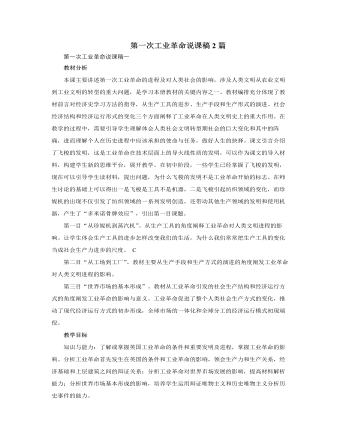
人教版高中历史必修2第一次工业革命说课稿2篇
3、工业革命引起社会关系变化——形成两大对立的工业资产阶级和无产阶级工业资产阶级和工业无产阶级成为社会的两大阶级。工业资产阶级获得更多的政治权利,各国通过改革,巩固了资产阶级的统治。 4、工业革命推动资产阶级调整内外政策——自由主义与殖民扩张对内,希望进一步摆脱封建束缚,要求自由经营、自由竞争和自由贸易。重商主义被自由放任政策所取代。对外,加快了殖民扩张和殖民掠夺的步伐。三、世界市场的基本形成1、原因条件(1)工业革命的展开使世界贸易的范围和规模迅速扩大1840年前后,英国的大机器工业基本上取代了工场手工业,率先完成了工业革命,成为世界上第一个工业国家。之后,法国和美国等国也相继完成工业革命。随着工业革命的展开,资产阶级竭力在全世界拓展市场,抢占原料产地,使世界贸易的范围和规模迅速扩大。
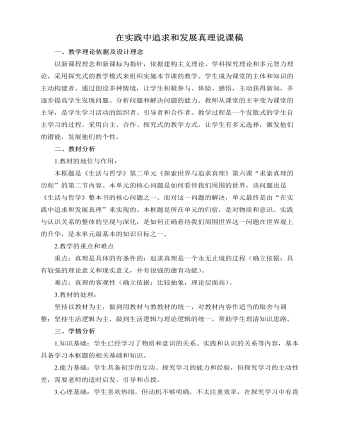
人教版高中政治必修4在实践中追求和发展真理说课稿(二)
一、教学理论依据及设计理念以新课程理念和新课标为指针,依据建构主义理论、学科探究理论和多元智力理论,采用探究式的教学模式来组织实施本节课的教学。学生成为课堂的主体和知识的主动构建者。通过创设多种情境,让学生积极参与、体验、感悟,主动获得新知,并逐步提高学生发现问题、分析问题和解决问题的能力。教师从课堂的主宰变为课堂的主导,是学生学习活动的组织者、引导者和合作者。教学过程是一个发散式的学生自主学习的过程。采用自主、合作、探究式的教学方式,让学生有多元选择,激发他们的潜能,发展他们的个性。二、教材分析1.教材的地位与作用:本框题是《生活与哲学》第二单元《探索世界与追求真理》第六课“求索真理的历程”的第二节内容。本单元的核心问题是如何看待我们周围的世界,该问题也是《生活与哲学》整本书的核心问题之一。
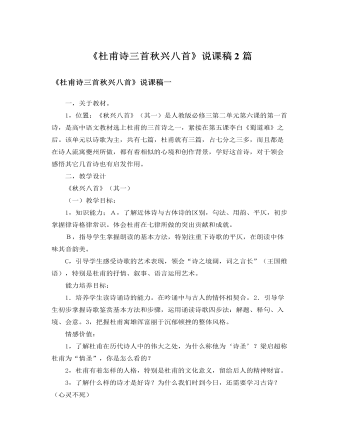
人教版高中语文必修3《杜甫诗三首 秋兴八首》说课稿2篇
师:“两开”是什么意思啊?注解里是怎么说的?第二次开,也就说他在这个地方已经待了两年了,这里是他回家的路途中,是不是?路途中他停留了两年时间。好的,你先请坐。你觉得残菊不能两开,在理解上好像存在一些误差。赵勇:因为菊花古往今来代表着对家乡的思念。师:菊花代表对家乡的思念?(下面学生齐笑)这种说法牵强了些,菊花在古代象征着高洁,梅兰竹菊是四君子嘛。赵勇:写这首诗时,他已经打算回故乡了,所以不应该写“残菊”,写“残菊”的话……师:事实上,他回不了故乡。好的,请坐。再想想,“残菊”意味着什么?破败。“丛菊”呢?茂盛。那这里说“两开他日泪”,“两开”是什么意思?开了两了次了,这说明他在这里已经待了两年了。那“他日泪”又是什么意思?赵勇:应该是他看到这里的菊花开得这么茂盛,就想到了故乡的菊花也是开的茂盛的时候。如果是“残菊”的话,那故乡的菊也会开得很残败。(下面学生齐笑)
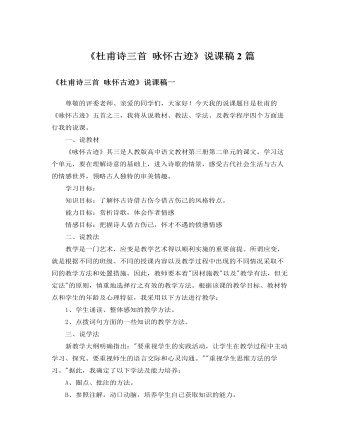
人教版高中语文必修3《杜甫诗三首 咏怀古迹》说课稿2篇
第三,说教学重点和难点。根据课程标准的具体要求、学生实际和社会实际以及教材的逻辑结构和教学体系,我认为本课的重难点是以下几个方面。教学重点:1.理解王昭君的形象2.深入理解杜甫在诗中的情感教学难点:理解寓意,把握主旨。第四,说教法与学法。教法:根据课文特点和学生实际情况,以诵读法(示范朗读、学生齐读)、问题探究法、点拨法、讨论分析法进行教学。首先激发学生学习本文的兴趣;然后引导学生反复吟哦诵读,在读的过程中质疑、思考、品析、鉴赏;最后在教师适当的点拨下,在集体的热烈讨论中,理解作者的感情,得到新的认识。(解说:使学生在教师的主导下围绕中心议题发表各自的意见,相互交流,相互启发,相互争议,激发他们主动去获取知识,培养健康情感。)
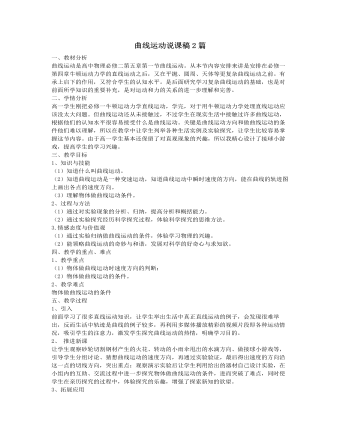
人教版新课标高中物理必修2曲线运动说课稿2篇
1、举例:2、结论:(1)物体的运动轨迹是曲线的运动叫曲线运动。(2)曲线运动中速度方向是时刻改变的。(二)、曲线运动方向:1、质点在某一点(或某一时刻)的速度的方向是在曲线的这一点的切线方向。2、曲线运动中速度方向是时刻改变的,因此曲线运动是变速运动。(三)、曲线运动条件:1、演示实验:2、结论:当物体所受的合力的方向跟它的速度方向不在同一直线时,物体就做曲线运动。七、课堂小结:1、运动轨迹是曲线的运动叫曲线运动。2、曲线运动中速度的方向是时刻改变的,质点在某一点的瞬时速度的方向在曲线的这一点的切线上。3、当合外力F的方向与它的速度方向有一夹角a时,物体做曲线运动。八、巩固训练:1、关于曲线运动,下列说法正确的是()。A:曲线运动一定是变速运动;B:曲线运动速度的方向不断的变化,但速度的大小可以不变;
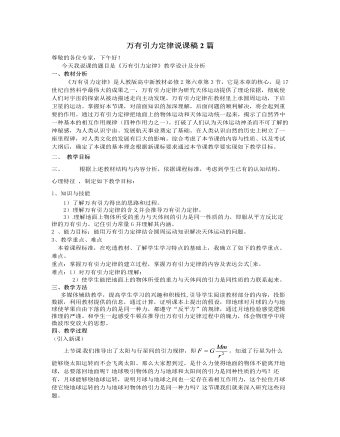
人教版新课标高中物理必修2万有引力定律说课稿2篇
学生中存在这样的问题:既然宇宙间的一切物体都是相互吸引的,那么为什么没有吸引到一起?为了解决这个问题,安排了例题2例2、两物体质量都是1kg,相距1m,它们间的万有引力是多少?通过本题,让学生认识到一般物体间的引力极小,不用考虑。那么,质量很大的天体为什么没被吸引到一块?从而引出下节课题。4.课堂小结:本节课,从天体运动出发,通过推理证明,形成理性认识,再结合例题习题使学生的理性认识再反馈到具体事实。形成实践-理论-实践的认知循环,顺应了认知规律.。本共设计了很多问,能让学生想的尽量让学生想、能学生说的尽量让学生说、能让学生做的尽量让学生做,全面发展学生的各方面能力。再通过作业和探究性课题使学生的思维活动在时空上得以延续。5.布置作业:布置作业时刻意安排引入:万有引力、重力、向心力、三者的联系,通过引导学生对比结果,从中发现问题:万有引力与重力向心力的关系与区别,为下节知识的难点突破作好了铺垫。
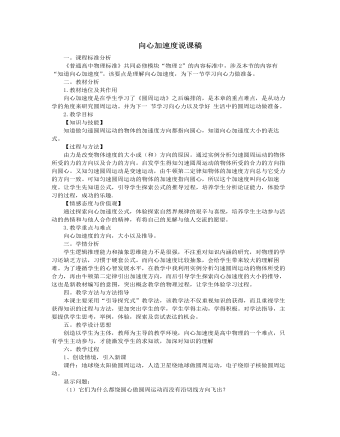
人教版新课标高中物理必修2向心加速度说课稿
d.某物体沿直线向东运动,原来的速度是5m/s,2s后速度减小到3m/s,求2s内物体速度变化。④如何探究物体作匀速圆周运动时,在Δt时间内的速度变化?分析:有了同一直线上速度变化的铺垫后,讨论物体做匀速圆周运动速度的变化就比较自然了,为了给向心加速度方向的学习打好基础,可以通过小组协作,进一步完成下列思考题,使同学们认识到:时间间隔起短,速度变化的方向起接近半径方向。(多媒体屏幕投影)a.物体沿半径为1m的轨道做匀速圆周运动,线速度大小为,求1s内物体速度变化并画出1s内速度变化的示意图。b.分别求出上题中物体在0.5s、0.25s内速度变化并画出相应的示意图。由于没有办法直接利用实验来验证速度变化的方向,所以,我们采用提供思考题的方法,引导同学在合作学习、自主探究中完成。有了速度变化的研究为铺垫,加速度的方向问题就迎刃而解了。
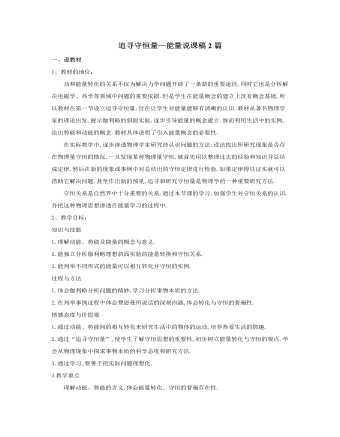
人教版新课标高中物理必修2追寻守恒量—能量说课稿2篇
[小结]师:下面同学们概括总结本节所学的内容。请一个同学到黑板上总结,其他同学在笔记本上总结,然后请同学评价黑板上的小结内容。 (学生认真总结概括本节内容,并把自己这节课的体会写下来、比较黑板上的小结和自己的小结,看谁的更好,好在什么地方。) 生:本节课我们通过伽利略理想斜面实验,分析得出了能量以及动能和势能的概念,从能量的相互转化角度认识到,在动能和势能的相互转化过程中,能的总量保持不变,即能量是守恒的。通过这节课的学习,使我们建立起了守恒的思想。 点评:总结课堂内容,培养学生概括总结能力。 教师要放开,让学生自己总结所学内容,允许内容的顺序不同,从而构建他们自己的知识框架。[布置作业]课后讨论 P3“问题与练习”中的问题。[课外训练]以竖直上抛的小球为例说明小球的势能和动能的转化情况。在这个例子中是否存在着能的总量保持不变?
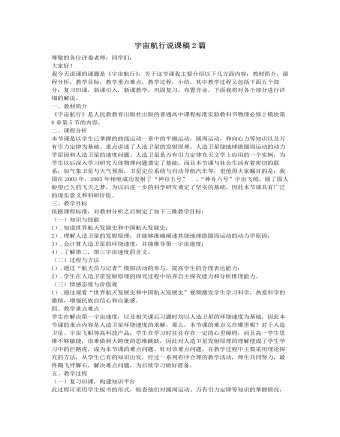
人教版新课标高中物理必修2宇宙航行说课稿2篇
了解了第一宇宙速度及其意义之后,继续提出问题,让学生思考:如果卫星的发射速度大于第一宇宙速度7.9km/s ,会出现什么情况呢?先让学生们大胆猜想,然后再向学生们介绍 卫星发射速度大于第一宇宙速度后的几种可能情况,引出第二宇宙速度和第三宇宙速度,让学生对第二、第三宇宙速度及其意义做定性了解。并通过演示Flash课件,帮助学生理解、加深学生印象。在学生对人造卫星的原理及发射卫星的速度条件有了初步了解后,接下来引导学生对卫星的运动规律作进一步的探索。实际上卫星并不是沿地表水平发射的,而是用火箭多次加速送到一定的高度的轨道后,再沿以地心为圆心的圆周的切线运行的。让学生继续深入思考:卫星在不同高度绕地球运行时的速度怎么求呢?将卫星送入低轨道和高轨道所需的速度都一样么?如果把不同轨道上的卫星绕地球的运动都看成是匀速圆周运动,引导学生利用已学的万有引力和圆周运动的相关知识,探究卫星绕地球的运行规律。
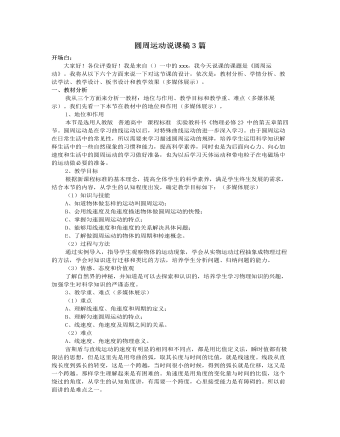
人教版新课标高中物理必修2圆周运动说课稿3篇
设计意图:通过设疑、讨论及学生的亲身体验与教师的引导,得到描述圆周运动快慢的两个物理量,也就成功的打破了学生在认识上的思维障碍,突破了物理概念教学的难点。在解决线速度和角速度的问题之后,我将引领学生学习匀速圆周运动的概念以及匀速圆周运动中线速度、角速度的特点。并引出匀速圆周运动中周期、转速的知识。为了加深学生对线速度、角速度与半径关系的认识,我设计了第三个学生体验活动:四名学生以我为圆心做圆周运动,四名学生始终并列,这时里圈同学走动不急不慢,而外圈同学则要小跑。通过学生的活动,不难发现在角速度相同的情况下,半径越大的线速度也越大。定性的得到了线速度、角速度与半径的关系。接下来让学生利用所学知识推导线速度、角速度与半径的关系。设计意图:这样就通过设疑、学生猜想、体验、推导的方式得到了结论,突破了本节课的难点即线速度、角速度与半径的关系。
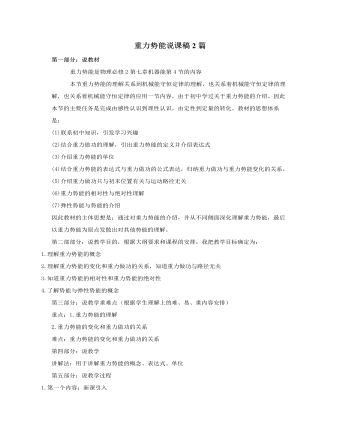
人教版新课标高中物理必修2重力势能说课稿2篇
(四)、弹性势能(据课时情况,可以让学生自学)生活中还有一些物体既没有运动也没有很大的高度却同样“储存”着能量,哪怕它只是孩童手里的玩具(图片:弹弓)。张紧的弓一撒手就会对箭支做功改变它的动能,松弛的弓有这样的本领吗?同样是弓前者具有能量而后者没有,那么什么情况下物体才具有这种能量呢?张紧的弓在恢复原状的过程会对外做功,但是拉断的弓还能有做功的本领吗?1.定义:物体由于发生弹性形变而具有的能量叫做弹性势能。2.弹性势能的大小与哪些因素有关呢?3、势能由相互作用的物体的相对位置决定的能量。重力势能:由地球和物体间相对位置决定。弹性势能:由发生形变的各部分的相对位置决定。(五).反馈练习1. 物体在运动过程中,克服重力做功50J, 则( )A.重力做功为50JB.物体的重力势能一定增加50JC.物体的重力势能一定减少50JD.重力做功为-50J
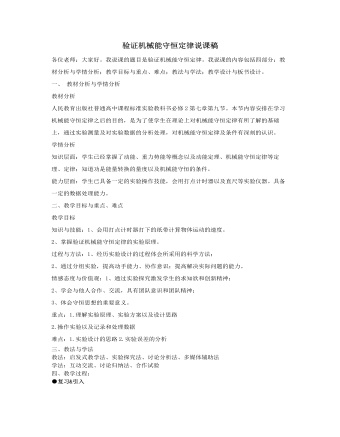
人教版新课标高中物理必修2验证机械能守恒定律说课稿
一、 教材分析与学情分析教材分析人民教育出版社普通高中课程标准实验教科书必修2第七章第九节。本节内容安排在学习机械能守恒定律之后的目的,是为了使学生在理论上对机械能守恒定律有所了解的基础上,通过实验测量及对实验数据的分析处理,对机械能守恒定律及条件有深刻的认识。学情分析知识层面:学生已经掌握了动能、重力势能等概念以及动能定理、机械能守恒定律等定理、定律;知道功是能量转换的量度以及机械能守恒的条件。能力层面:学生已具备一定的实验操作技能,会用打点计时器以及直尺等实验仪器。具备一定的数据处理能力。二、教学目标与重点、难点教学目标知识与技能:1、会用打点计时器打下的纸带计算物体运动的速度。2、掌握验证机械能守恒定律的实验原理。
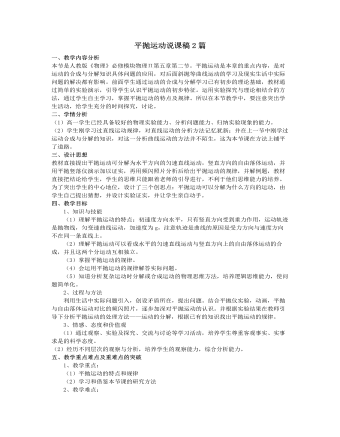
人教版新课标高中物理必修2平抛运动说课稿2篇
(5)高度不同,对平抛运动距离有何影响,是否因为高度减小后下落时间减小,所以要增大速度才能达到相同的距离?(教学实践证明,这种想法在学生比较多见。已经不自觉的沿用了自由落体运动的规律,又隐隐有运动等时性的痕迹。应引导学生这一结果还需实验验证。)教师的引导:其实,我们所提出的看法都跟平抛运动的规律有关系。那么平抛运动究竟有怎样的规律呢?以前学过的直线运动知识还能用于今天的内容吗?由此逐步使学生意识到分析平抛运动须采用运动合成与分解这一方法。三、实验验证自主探究(15分钟) 物理是实验科学,多媒体教学不能代替实验。本教学设计的第三个环节是实验验证,鼓励学生自主探究。引导学生根据自己的猜想(实验目的)设计实验进行验证。(1)介绍手持式平抛竖落仪,引导并小结实验要领:听两小球下落声音判断其下落时间。体会合运动和分运动是等时的。
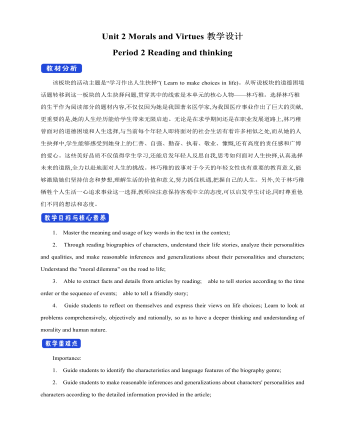
新人教版高中英语必修3Unit 2 Morals and Virtues教学设计二
Activity 41. Students complete the task of activity 4, then teachers and students check the answers. 2. The teacher organized the students to work together and asked them to use the tables and mind maps sorted out before to retold the important choices in Lin Qiaozhi's life and their resultsStep 5 Language points1. The teacher asks the students to read the text carefully, find out the core words and long and difficult sentences in the text and draw lines, understand the use of vocabulary, and analyze the structure of long and difficult sentences. 2. The teacher explains and summarizes the usage of core vocabulary and asks the students to take notes. 3. The teacher analyzes and explains the long and difficult sentences that the students don't understand, so that the students can understand them better. Step 6 Homework1. Read the text again, in-depth understanding of the text; 2. Master the use of core vocabulary and understand the long and difficult sentences. 3. Complete relevant exercises in the guide plan. 1、通过本节内容学习,学生是否理解和掌握阅读文本中的新词汇的意义与用法;2、通过本节内容学习,学生能否结合文本特点总结林巧稚的人生原则和人格品质特征;3、通过本节内容学习,学生能否针对人生抉择发表自己的看法;能否全面地、客观地、理性地看待问题,进而对道德和人性有更加深入的思考和理解。
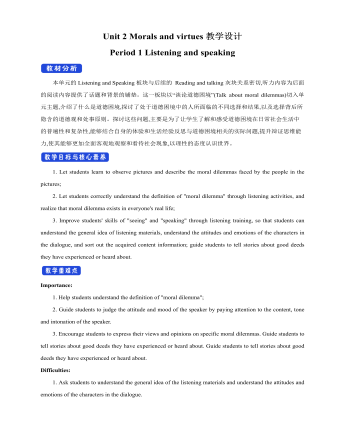
新人教版高中英语必修3Unit 2 Morals and virtues教学设计一
(2) students are divided into groups according to the requirements of activity 3. Each student shares a story of personal experience or hearing-witnessing kindness, and then selects the most touching story in the group and shares it with the whole class. Before the students share the story, the teacher can instruct them to use the words and sentence patterns in the box to express. For example, the words in the box can be classified:Time order: first of all, then, after that, later, finally logical relationship :so, however, although, butTeachers can also appropriately add some transitional language to enrich students' expression:Afterwards, afterwards, at last, in the end, eventuallySpatial order: next to, far from, on the left, in front ofOtherwise, nevertheless, as a result, therefore, furthermore, in addition, as well asSummary: in a word, in short, on the whole, to sum up, in briefStep 8 Homework1. Understand the definition of "moral dilemma" and establish a correct moral view;2. Accumulate vocabulary about attitudes and emotions in listening texts and use them to express your own views;3. Complete relevant exercises in the guide plan.1、通过本节内容学习,学生能否理解理解“道德困境”的定义;2、通过本节内容学习,学生能否通过说话人所表达的内容、说话的语气、语调等来判断其态度和情绪;3、通过本节内容学习,学生能否针对具体的道德困境发表自己的看法和见解,能否掌握听力理训练中的听力策略。
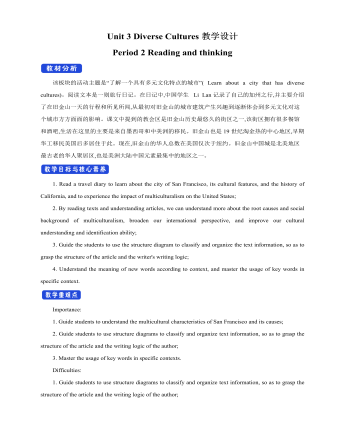
新人教版高中英语必修3Unit 3 Diverse Cultures教学设计二
(2)Consolidate key vocabulary.Ask the students to complete the exercises of activity 6 by themselves. Then ask them to check the answers with their partners.(The first language:Damage of the 1906 San Francisco earthquake and fire.A second language: Yunnan - one of the most diverse provinces in China).Step 5 Language points1. The teacher asks the students to read the text carefully, find out the more words and long and difficult sentences in the text and draw lines, understand the use of vocabulary, and analyze the structure of long and difficult sentences.2. The teacher explains and summarizes the usage of core vocabulary and asks the students to take notes.3. The teacher analyzes and explains the long and difficult sentences that the students don't understand, so that the students can understand them better.Step 6 Homework1. Read the text again, in-depth understanding of the text;2. Master the use of core vocabulary and understand the long and difficult sentences.3. Complete relevant exercises in the guide plan.1、通过本节内容学习,学生是否理解和掌握阅读文本中的新词汇的意义与用法;2、通过本节内容学习,学生能否结合文本特点了解文章的结构和作者的写作逻辑;3、通过本节内容学习,学生能否了解旧金山的城市风貌、文化特色,以及加利福尼亚州的历史,体会多元文化对美国的影响。
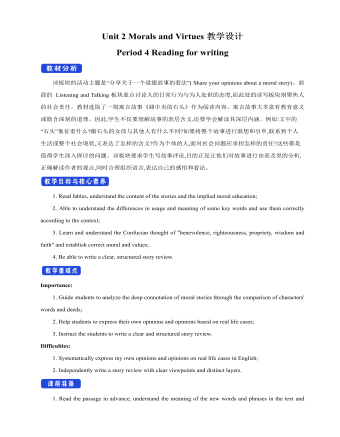
新人教版高中英语必修3Unit 2 Morals and Virtues教学设计四
3.Teachers ask different groups to report the answers to the questions and ask them to try different sentence patterns.The teacher added some sentence patterns for students to refer to when writing.Step 4 Writing taskActivity 51.Write the first draft.Students first review the evaluation criteria in activity 5, and then independently complete the draft according to the outline of activity 4, the answers to the questions listed in the group discussion and report, and the reference sentence pattern.2.Change partners.The teacher guides the students to evaluate their partner's composition according to the checklist of activity 5 and proposes Suggestions for modification.3.Finalize the draft.Based on the peer evaluation, students revise their own compositions and determine the final draft.Finally, through group recommendation, the teacher selects excellent compositions for projection display or reading aloud in class, and gives comments and Suggestions.Step 5 Showing writingActivity 5T call some Ss to share their writing.Step 6 Homework1. Read the passage in this section to better understand the passage.2. Carefully understand the hierarchical structure of the article, and deeply understand the plot of the story according to the causes, process and results;3. Independently complete the relevant exercises in the guide plan.1、通过本节内容学习,学生是否理解和掌握阅读文本中的新词汇的意义与用法;2、通过本节内容学习,学生能否通过人物言行的对比分析道德故事的深层内涵;3、通过本节内容学习,学生能否根据故事的起因、经过和结果来深入理解故事的情节,从而了解文章的层次结构;4、结合现实生活案例发表自己的见解和看法,写一篇观点明确、层次分明的故事评论。
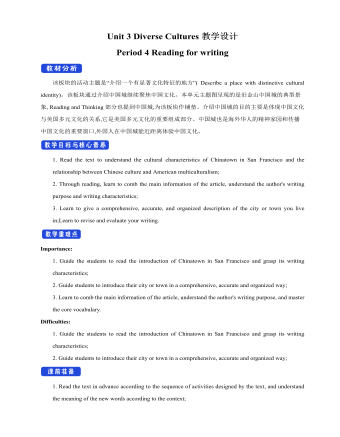
新人教版高中英语必修3Unit 3 Diverse Cultures教学设计四
该板块的活动主题是“介绍一个有显著文化特征的地方”( Describe a place with distinctive cultural identity)。该板块通过介绍中国城继续聚焦中国文化。本单元主题图呈现的是旧金山中国城的典型景象, Reading and Thinking部分也提到中国城,为该板块作铺垫。介绍中国城的目的主要是体现中国文化与美国多元文化的关系,它是美国多元文化的重要组成部分。中国城也是海外华人的精神家园和传播中国文化的重要窗口,外国人在中国城能近距离体验中国文化。1. Read the text to understand the cultural characteristics of Chinatown in San Francisco and the relationship between Chinese culture and American multiculturalism;2. Through reading, learn to comb the main information of the article, understand the author's writing purpose and writing characteristics;3. Learn to give a comprehensive, accurate, and organized description of the city or town you live in;Learn to revise and evaluate your writing.Importance:1. Guide the students to read the introduction of Chinatown in San Francisco and grasp its writing characteristics;2. Guide students to introduce their city or town in a comprehensive, accurate and organized way;3. Learn to comb the main information of the article, understand the author's writing purpose, and master the core vocabulary.
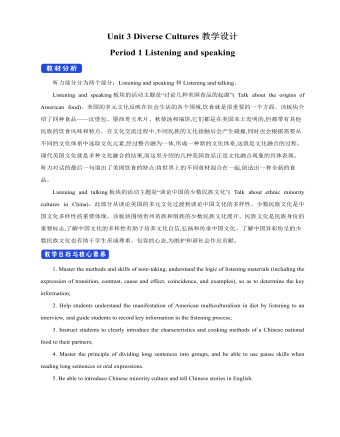
新人教版高中英语必修3Unit 3 Diverse Cultures教学设计一
Activity 81.Grasp the main idea of the listening.Listen to the tape and answer the following questions:Who are the two speakers in the listening? What is their relationship?What is the main idea of the first part of the listening? How about the second part?2.Complete the passage.Ask the students to quickly review the summaries of the two listening materials in activity 2. Then play the recording for the second time.Ask them to complete the passage and fill in the blanks.3.Play the recording again and ask the students to use the structure diagram to comb the information structure in the listening.(While listening, take notes. Capture key information quickly and accurately.)Step 8 Talking Activity 91.Focus on the listening text.Listen to the students and listen to the tape. Let them understand the attitudes of Wu Yue and Justin in the conversation.How does Wu Yue feel about Chinese minority cultures?What does Justin think of the Miao and Dong cultures?How do you know that?2.learn functional items that express concerns.Ask students to focus on the expressions listed in activity. 3.And try to analyze the meaning they convey, including praise (Super!).Agree (Exactly!)"(You're kidding.!)Tell me more about it. Tell me more about it.For example, "Yeah Sure." "Definitely!" "Certainly!" "No kidding!" "No wonder!" and so on.4.Ask the students to have conversations in small groups, acting as Jsim and his friends.Justin shares his travels in Guizhou with friends and his thoughts;Justin's friends should give appropriate feedback, express their interest in relevant information, and ask for information when necessary.In order to enrich the dialogue, teachers can expand and supplement the introduction of Miao, dong, Lusheng and Dong Dage.After the group practice, the teacher can choose several groups of students to show, and let the rest of the students listen carefully, after listening to the best performance of the group, and give at least two reasons.





















